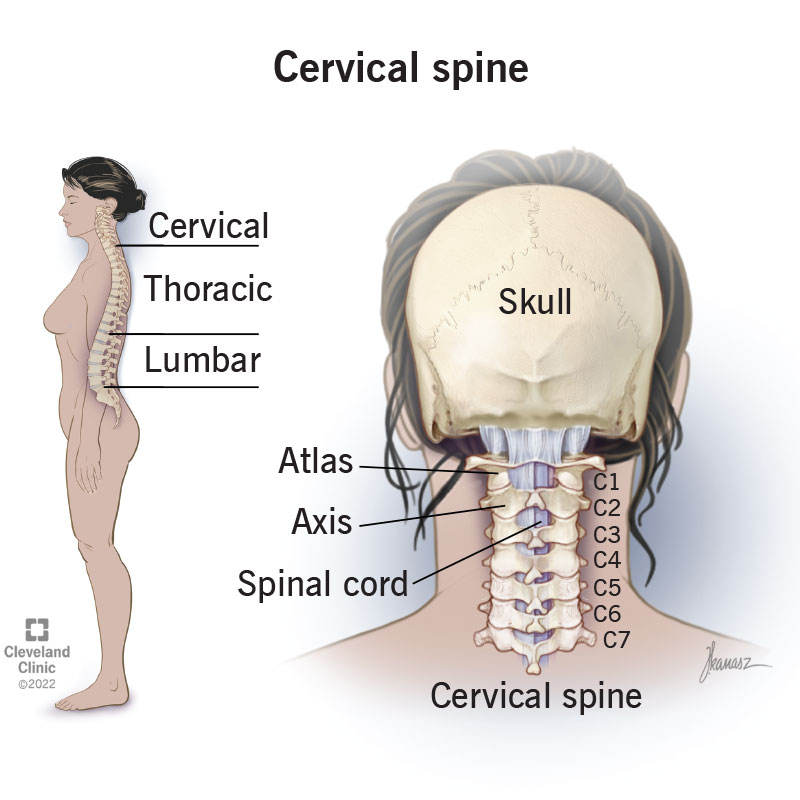Your cervical spine consists of the first seven vertebrae in your spine. It provides support for the weight of your head, surrounds and protects your spinal cord, and allows for a wide range of head motions. Many conditions affect this area of your spine, including neck pain, arthritis, degenerative bone and disk disease, and stenosis. Many treatment options are available.
Advertisement
Cleveland Clinic is a non-profit academic medical center. Advertising on our site helps support our mission. We do not endorse non-Cleveland Clinic products or services. Policy

Your cervical spine — the neck area of your spine — consists of seven stacked bones called vertebrae. The first two vertebrae of your cervical spine are unique in shape and function. Your first vertebra (C1), also called the atlas, is a ring-shaped bone that begins at the base of your skull. It’s named after Atlas, of Greek mythology, who held the world on his shoulders. The atlas holds your head upright. Your second vertebra (C2), also called the axis, allows the atlas to pivot against it for the side-to-side “no” rotation of your head.
Advertisement
Cleveland Clinic is a non-profit academic medical center. Advertising on our site helps support our mission. We do not endorse non-Cleveland Clinic products or services. Policy
Your seven cervical vertebrae (C1 to C7) are connected at the back of the bone by a type of joint (called facet joints), which allow for the forward, backward and twisting motions of your neck.
Your cervical spine is also surrounded by muscles, nerves, tendons and ligaments. “Shock-absorbing” disks, called intervertebral disks, are positioned between each vertebra. Your spinal cord runs through the center of your entire spine. Your spinal cord sends and receives messages from your brain, which controls all aspects of your body’s functions.
Your cervical spine has several functions, including:
Advertisement
Other structures around or involving your cervical spine include the following:
The major muscles that attach to your cervical spine include:
Ligaments in your cervical spine connect bone to bone to help to keep your cervical spine stable. Three major cervical spine ligaments are:
Cervical disks are the “shock absorber cushions” that sit between each vertebra. A total of six disks are positioned between the seven cervical vertebrae (one between two vertebrae). In addition to cushioning against stresses placed on your neck, the disks allow you to flex and rotate your head more easily during activity.
Eight pairs of spinal nerves exit through small openings (foramen) between every pair of vertebrae in your cervical spine. They’re labeled C1 through C8. They stimulate muscle movement in your neck, shoulder, arm and hand, and provide sensation.
Advertisement
Your spinal cord is a bundle of nerve tissue that extends from the lower part of your brain to your body. It carries messages between your brain and the muscles mentioned above.
Advertisement
Many diseases and conditions result from problems in the cervical spine and the surrounding soft tissues and nerves. These include:
Advertisement
First, your healthcare provider will gather your medical and medication history, ask you about your symptoms, perform a physical exam and order tests and imaging studies.
Tests and imaging may include:
Both nonsurgical treatment options and surgery are available to treat many of the conditions that affect the cervical spine. The choice depends on the cause of the cervical spine issue and its severity.
Your healthcare provider may first recommend less invasive approaches for neck pain that aren’t caused by trauma or a tumor. Some common nonsurgical treatment options include:
You may be a candidate for cervical spine surgery if:
Common surgical approaches include:
Cervical spinal decompression surgery is a general term that refers to various procedures used to relieve symptoms caused by pressure, or compression, on your spinal cord or nerve roots. Nerve roots are the first segment of a nerve that leaves your spinal cord through the small hollows between the vertebrae. Common surgical techniques for decompression include:
Cervical disk replacement surgery involves removing a diseased cervical disk and replacing it with an artificial disk. The most common reason for this procedure is cervical disk degeneration.
Cervical spinal fusion is surgery that permanently connects to one or more cervical vertebrae. The surgery eliminates the motion between vertebrae.
Functional electrical stimulation for spinal cord injury. This procedure uses small electrical impulses to activate specific muscles and nerves to restore function to your upper body muscles controlled by cervical nerves.
Speak with your surgeon. In many cases, minimally invasive spine surgery is an option. Compared to the one large incision through your skin with traditional open surgery, minimally invasive surgery is performed through one or more smaller incisions. Working through smaller incisions causes much less damage to muscles and soft tissues than a single long incision.
Your cervical spine is the neck region of your spinal column or backbone. It consists of your first seven bones (C1-C7). Other structures in or around your cervical spine are your intervertebral disks, spinal cord and nerves, muscles, tendons and ligaments. Your cervical spine supports the weight of your head and allows a wide range of head movement. Its circular surround of bone also protects your spinal cord. Many diseases and disorders can affect your cervical spine. Fortunately, many nonsurgical and surgical options can treat these conditions.
If you have a neurological condition, you want expert advice. At Cleveland Clinic, we’ll work to create a treatment plan that’s right for you.

Last reviewed on 01/18/2022.
Learn more about the Health Library and our editorial process.